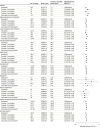Association of Maternal Influenza Vaccination During Pregnancy With Early Childhood Health Outcomes
- PMID: 34100870
- PMCID: PMC8188273
- DOI: 10.1001/jama.2021.6778
Association of Maternal Influenza Vaccination During Pregnancy With Early Childhood Health Outcomes
Abstract
Importance: Seasonal influenza vaccination in pregnancy can reduce influenza illness among pregnant women and newborns. Evidence is limited on whether seasonal influenza vaccination in pregnancy is associated with adverse childhood health outcomes.
Objective: To assess the association between maternal influenza vaccination during pregnancy and early childhood health outcomes.
Design, setting, and participants: Retrospective cohort study, using a birth registry linked with health administrative data. All live births in Nova Scotia, Canada, between October 1, 2010, and March 31, 2014, were included, with follow-up until March 31, 2016. Adjusted hazard ratios (HRs) and incidence rate ratios (IRRs) with 95% confidence intervals were estimated while controlling for maternal medical history and other potential confounders using inverse probability of treatment weighting.
Exposures: Seasonal influenza vaccination during pregnancy.
Main outcomes and measures: Childhood outcomes studied were immune-related (eg, asthma, infections), non-immune-related (eg, neoplasms, sensory impairment), and nonspecific (eg, urgent or inpatient health care utilization), measured from emergency department and hospitalization databases.
Results: Among 28 255 children (49% female, 92% born at ≥37 weeks' gestation), 10 227 (36.2%) were born to women who received seasonal influenza vaccination during pregnancy. During a mean follow-up of 3.6 years, there was no significant association between maternal influenza vaccination and childhood asthma (incidence rate, 3.0 vs 2.5 per 1000 person-years; difference, 0.53 per 1000 person-years [95% CI, -0.15 to 1.21]; adjusted HR, 1.22 [95% CI, 0.94 to 1.59]), neoplasms (0.32 vs 0.26 per 1000 person-years; difference, 0.06 per 1000 person-years [95% CI, -0.16 to 0.28]; adjusted HR, 1.26 [95% CI, 0.57 to 2.78]), or sensory impairment (0.80 vs 0.97 per 1000 person-years; difference, -0.17 per 1000 person-years [95% CI, -0.54 to 0.21]; adjusted HR, 0.82 [95% CI, 0.49 to 1.37]). Maternal influenza vaccination in pregnancy was not significantly associated with infections in early childhood (incidence rate, 184.6 vs 179.1 per 1000 person-years; difference, 5.44 per 1000 person-years [95% CI, 0.01 to 10.9]; adjusted IRR, 1.07 [95% CI, 0.99 to 1.15]) or with urgent and inpatient health services utilization (511.7 vs 477.8 per 1000 person-years; difference, 33.9 per 1000 person-years [95% CI, 24.9 to 42.9]; adjusted IRR, 1.05 [95% CI, 0.99 to 1.16]).
Conclusions and relevance: In this population-based cohort study with mean follow-up duration of 3.6 years, maternal influenza vaccination during pregnancy was not significantly associated with an increased risk of adverse early childhood health outcomes.
Conflict of interest statement
Figures

Comment in
-
Realizing the Potential of Maternal Influenza Vaccination.JAMA. 2021 Jun 8;325(22):2257-2259. doi: 10.1001/jama.2021.7776. JAMA. 2021. PMID: 34100881 Free PMC article. No abstract available.
References
-
- Department of Reproductive Health and Research . Seasonal influenza. World Health Organization. Accessed March 18, 2021. https://www.who.int/ith/diseases/influenza_seasonal/en/
Publication types
MeSH terms
Substances
LinkOut - more resources
Full Text Sources
Medical

